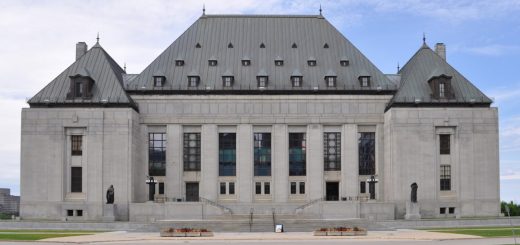Re Shortt: ONCA Finds 6-Year Delay Discharging NCR Man to Appropriate Community Living Unconstitutional

In October, the Ontario Court of Appeal (“ONCA”) released its decision in Re Shortt, 2020 ONCA 651 [Shortt] requiring the Government to fund an appropriate community living placement for Mr. Shortt to end his unnecessarily prolonged stay in forensic custody. While Justice MacPherson was clear that this remedy applied only to Mr. Shortt, and that Mr. Shortt’s case was unusual and exceptional, Shortt may pave the way for others trapped in forensic custody to assert their constitutional rights and end the ongoing deprivation of their liberty.
Background
Mr. Wesley Shortt, a man with “severe physical and intellectual disabilities,” had been detained at St. Joseph’s Healthcare, a psychiatric hospital in Hamilton, for over 13 years (Shortt, paras 7-8). In 2006, while he was living with his parents, he threatened to kill his father during an argument; his parents called the police, and Mr. Shortt was arrested (Shortt, para 7). At trial, he was found not criminally responsible (“NCR”), and ever since, he has been detained at St. Joseph’s. However, in every annual review since 2014, the Ontario Review Board (“Board”) found him eligible to live in community housing with appropriate support rather than mandating his continued detention (Shortt, paras 1-2). Despite these findings, Mr. Shortt remained at St. Joseph’s because “despite its best efforts, the Hospital has been unable to locate a suitable setting or to obtain meaningful information from the Government of Ontario as to when such a setting might become available” (Shortt, para 3). Over this time, Mr. Shortt grew increasingly frustrated, and his condition deteriorated from “the distress caused by his ongoing detention in a forensic hospital, in the face of six consecutive annual Board orders that he is eligible to reside in the community” (Shortt, para 9).
Given this 6-year-long delay in implementing the Board’s recommendations, Mr. Shortt brought an application under the Canadian Charter of Rights and Freedoms [Charter] at his latest Board review hearing, arguing that his continued detention at St. Joseph’s violated his section 7 right to liberty in an arbitrary manner (Shortt, para 4). As part of his application, he argued that the appropriate remedy would be an order for the Government to pay for his community housing under section 24(1) of the Charter (Shortt, paras 4, 12). The Board dismissed his Charter application, finding that it did not have the jurisdiction to grant the remedy Mr. Shortt was asking for, so Mr. Shortt appealed the decision directly to the ONCA.
ONCA Decision
Jurisdiction
The decision began by addressing the Board’s finding that it did not have the proper authority or jurisdiction to grant Mr. Shortt’s request. First, Justice MacPherson responded to the Board’s conclusion that Mr. Shortt’s Charter application was seeking “a systemic remedy to a province-wide housing shortage for disabled persons rather than a personal remedy for Mr. Shortt’s five-year detention in a forensic hospital after he was eligible for living in the community” (Shortt, para 25). Justice MacPherson was “not persuaded” by this conclusion, and instead found that Mr. Shortt was seeking a personal remedy—that he himself be released from forensic custody and placed in community housing (Shortt, para 26). Justice MacPherson also rejected the Board’s claim that it did not have the jurisdiction to grant Mr. Shortt’s proposed remedy. Previous ONCA jurisprudence had held that the Board did not have jurisdiction to award costs or damages, and based on this finding, the Board concluded that a funding order for Mr. Shortt’s housing would be outside their jurisdiction (Shortt, paras 33, 36). However, Justice MacPherson differentiated between funding orders and costs or damages—largely on the basis that funding orders, such the one being sought by Mr. Shortt, are not punitive unlike costs or damages—to conclude that this precedent did not prohibit the Board from making funding orders (Shortt, para 37).
Although Justice MacPherson concluded that the Board did have jurisdiction to hear Mr. Shortt’s Charter arguments, he did not remit the case to the Board to decide, instead finding that ONCA was “well-positioned” to determine Mr. Shortt’s Charter arguments, as it had heard submissions from all parties and an intervener and had the full record that was before the Board (Shortt, para 40).
Section 7 Claim
Mr. Shortt claimed that the Government’s failure to provide funding to allow him to live in the community unjustly deprived him of liberty. In assessing the deprivation of Mr. Shortt’s liberty in the context of his NCR designation, Justice MacPherson pointed to the Supreme Court of Canada’s decision in Winko v British Columbia (Forensic Psychiatric Institute), [1999] 2 SCR 625 [Winko], which held that the objective of the NCR regime was to “protect the public from the NCR accused who poses a significant threat to public safety while safeguarding the NCR accused’s liberty to the maximum extent possible” (Winko at para 70, quoted in Shortt, para 47). Thus, while Mr. Shortt’s liberty may be deprived in the context of the NCR regime, it must be done in the “least onerous and least restrictive” manner possible (Winko at para 70).
The Attorney General of Ontario (“AGO”) argued that Mr. Shortt’s liberty was not deprived, contending that “the difference between living in the Hospital and living in the community would be so small that the relevant deprivation of liberty cannot rise to the level required by s. 7” (Shortt, para 49). Justice MacPherson, however, noted that in analyzing deprivations of liberty under section 7, there is no specific threshold that must be met (Shortt, para 51). The AGO also argued that Mr. Shortt’s liberty was not deprived because he had been granted more liberties within the Hospital since 2014 (Shortt, para 49). Justice MacPherson similarly repudiated this argument, noting that “more liberty does not accord with the requirement for maximum liberty,” as Winko requires (Shortt, para 50). Justice MacPherson concluded that community living is clearly less restrictive than forensic custody, as it allows for “more freedom and fewer restrictions,” and as such, that Mr. Shortt’s right to liberty had been infringed since he was not subject to the least onerous conditions possible in his circumstances (Shortt, paras 50, 52).
A section 7 violation requires not only a deprivation of liberty, but the claimant must also prove that the deprivation was not in accordance with a principle of fundamental justice. Mr. Shortt claimed that the deprivation of his liberty was arbitrary, which would require a lack of connection between the objective of the law and the deprivation of the right (Shortt, paras 53-54). The only reason for Mr. Shortt’s continued liberty deprivation was the lack of funding for community living. Justice MacPherson held that “[l]ack of funding, as a potential justification for the deprivation of Mr. Shortt’s liberty, does not properly fall within the scope of the s. 7 analysis,” but instead should be considered under section 1 (Shortt, para 55). He concluded that there was no rational connection between Mr. Shortt’s ongoing detention and the purposes of the NCR regime, as Mr. Shortt would pose no threat to public safety if in a community living setting; thus, Justice MacPherson agreed with Mr. Shortt that the deprivation was arbitrary (Shortt, paras 58-59).
Finally, Justice MacPherson briefly dismissed any possibility of justification under section 1, as the AGO did not raise any arguments that the section 7 violation could be saved by section 1 (Shortt, para 60). He did not return to the argument of lack of funding, which several paragraphs earlier he held was properly adjudicated under section 1.
Remedy
Based on evidence from doctors, social workers, hospital staff, and the Board itself confirming that the only obstacle to Mr. Shortt’s release from forensic custody was the lack of funding, Justice MacPherson determined that Mr. Shortt’s sought remedy, an order that the Government provide him with appropriate community housing in a timely fashion, was an appropriate response to the extraordinary circumstances of Mr. Shortt’s case (Shortt, paras 77-78). He added two components to this order. First, he noted that because 14 months had passed since the Board’s last assessment of Mr. Shortt, the Board would need to conduct a new annual review to ensure that its assessment of his risk remained consistent (Shortt, paras 79-80). Second, he ordered that the Government must, at this annual review, be ready to identify the precise location where Mr. Short can be placed by the end of 2020 (Shortt, para 81).
Justice MacPherson concluded by summarizing the unusual circumstances of Mr. Shortt’s situation—both to demonstrate the gravity of the Government’s failure to fund his community housing, but also, perhaps, to emphasize that the remedy granted to Mr. Shortt should not be treated as a commonly available remedy for those in forensic custody:
This is an exceptional case. For six years running, the Board has deemed Mr. Shortt capable of living in the community at the discretion of the Person in Charge of the Hospital. For six years running, the Hospital has deemed Mr. Shortt capable of living in the community. The difficulty is that, despite its best efforts, the Hospital has not been able to determine why an appropriate residential setting has not been made available for Mr. Shortt or even when one may be made available. As a result, Mr. Shortt has been languishing in the Hospital and his condition is starting to deteriorate, a development that stands as the antithesis to one of the ultimate purposes of the NCR scheme, to work safely toward the reintegration of NCR accused back into society (Shortt, para 82).
Analysis
As Justice MacPherson emphasizes, Shortt is an unusually grave case of the deprivation of liberty arising from an NCR finding, given Mr. Shortt’s six additional years in forensic custody after the Board deemed him safe to live in community housing. However, the government’s lack of funding for community living alternatives surely does not only affect Mr. Shortt. How many others have remained in forensic custody longer than necessary due to insufficient government funding for community living supports? While Mr. Shortt’s six-year period may be exceptional, it is hard to believe his case is unique. Past Board decisions referred to by Justice MacPherson expressed a similar frustration at the “low priority” given to those in forensic custody by Development Services Ontario when allocating funding (Shortt, para 68), and in Mr. Shortt’s decision, the Board noted that “it is a sad situation for Mr. Shortt and many, many others in his situation that the lack of proper funding forces NCR patients to stay in hospital longer” than necessary (Shortt, para 25). Clearly, Mr. Shortt is not the only individual whose liberties have been restricted far more than necessary, and for far longer than necessary.
While Justice MacPherson was clear in the decision that Mr. Shortt was seeking a personal remedy rather than a systemic remedy, bringing his claim within the Board’s jurisdiction, it is evident that systemic change is needed in order to account for the “many, many others” in Mr. Shortt’s situation, whose unnecessarily prolonged detention in forensic custody will remain unchanged following this decision. However, perhaps this decision will at least open the door for others to bring similar claims—though they will need to overcome the likely argument that Mr. Shortt’s situation was unique and is not easily analogized to others who have not been held in forensic custody for as long as he was after being found eligible for release into community living. Finally, while unlikely, we can only hope that this rebuke from the ONCA motivates the Government to seek more sustainable, long-term solutions to the chronic underfunding of supportive community living settings for those deemed NCR.
Conclusion
Because of this decision, Mr. Shortt’s prolonged and unnecessary detention will be brought to an end—assuming his next review hearing, scheduled for later in November, arrives at the same conclusion about his risk to public safety (Shortt, paras 79-80). While Shortt’s remedy is confined only to Mr. Shortt’s situation, it may open the door for future claims to be brought by others who have similarly been detained long past the Board’s recommendations due to insufficient funding for the necessary community living supports. The Government has 60 days from the date of the Court of Appeal decision—in this case, October 16th—within which to apply for leave to appeal to the Supreme Court of Canada, which they may wish to do to avoid setting a precedent requiring increased funding for community living settings. However, the unanimous ONCA ruling, and the strong and convincing decision of Justice MacPherson, may make obtaining leave a challenge.








Join the conversation